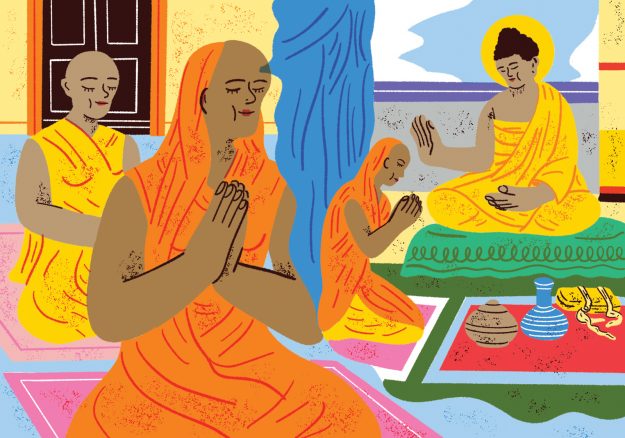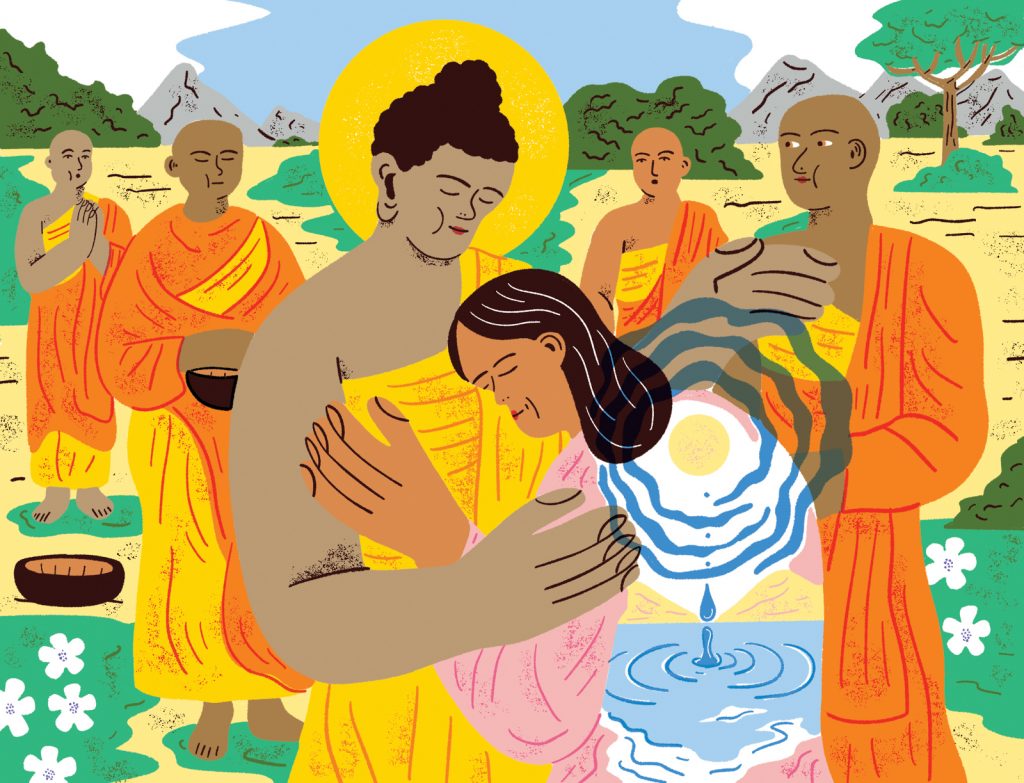From a distance, she saw that the Blessed One was beautiful, pleasing, his senses were at peace, his heart at peace, and his mind absolutely serene. He was as shining and radiant as a golden pillar. What is more, she perceived the Blessed One to be her own son.
—Karmashataka Sutra
When we hear the word karma, we sometimes feel uneasy. The temptation is to believe it means that every outcome is predetermined. We may feel trapped—by what we’ve done, by whom we’ve been with, or by our present circumstances. It seems impossible that things could be otherwise. But what karma really means for us is the ability to proactively shape our future.
The Karmashataka Sutra, known in English as The Hundred Deeds Sutra, tells the story of one woman’s extraordinary encounter with the Buddha. Her narrative teaches us the importance of aspiration in shifting our personal trajectories, and how responsive relationships can turn our lives around even as past karma lingers. It’s called “The Story of Kachangkala.”
One day the Buddha was visiting a village in Otala, where he and other monks were making their daily alms round. A woman named Kachangkala had gone out for water when she glimpsed the Buddha from a distance. His every movement conveyed that his senses, body, and heart were at peace. Kachangkala also found something about him remarkably familiar—so familiar, in fact, that she mistook him to be her own son.
She hurried to place her pot on the ground and ran toward him with her arms flung open wide, crying out, “My son! My son!”
The monks, alarmed, instinctively closed ranks around the Buddha, blocking her attempt to embrace him. The Buddha shared none of the monks’ repulsion at her desperation and impulsivity. He responded with compassion for Kachangkala and gently corrected them.
“Monks, do not hinder her,” he said. “If you don’t let this woman take the Tathagata in her arms, she will spew warm blood from her mouth and die”—a physical expression of the brokenheartedness she would feel. He was calling her to him.
Reassured by his instruction, the monks relented, and Kachangkala drew the Buddha into her embrace.
This moment must have been mind-blowing—the vinaya, the monastic code, expressly forbade a monk to have physical contact with a woman, yet here the Buddha was in Kachangkala’s arms. The greatness of the Buddha’s compassion and his complete lack of self-interest stilled the torment in her heart. It must have felt like utter serenity to her.
The story does not tell us at what point Kachangkala realized that the man she held was not her son but the Buddha himself. We are told that she held him in her arms for a little while and that when she let go, she sat down calmly before him to listen to a teaching.
The monastic code expressly forbade a monk to have physical contact with a woman, yet here the Buddha was in Kachangkala’s arms.
The Buddha looked deeply into Kachangkala’s heart, and he taught her the dharma in a way particularly suited to her. The truth of what the Buddha spoke shot through her, dissolving her misconceptions about reality. Assuming a traditional posture of humility, she made a formal request to take ordination as a nun. As the story describes it:
Having seen the truth, she rose from her seat, drew down the right shoulder of her upper garment [to show respect], bowed toward the Blessed One with palms together, and implored him, “Blessed One, if permitted I wish to go forth in the dharma and Vinaya so well spoken, complete my novitiate, and achieve full ordination. In the presence of the Blessed One, I too wish to practice the holy life.”
The Buddha accepted her plea and later introduced her to Mahaprajapati Gautami, his aunt, who had raised him after his mother’s death. Mahaprajapati was the head of the nuns’ order, and it was under her instruction that Kachangkala took all the different levels of nuns’ vows.
After her ordination, Kachangkala devoted herself single-mindedly to spiritual practice and eventually became an arhat, a being of tremendous realization. At this level of insight she experienced total freedom and was no longer subject to afflictive emotions:
Her mind regarded gold no differently than filth and saw the palms of her hands as like space itself. She became cool like wet sandalwood. Her insight crushed ignorance like an eggshell. . . . She had no regard for worldly profit, passion, or acclaim.
So great were her accomplishments that the Buddha proclaimed her to be among nuns “foremost of those who interpret the sutras.”

The monks, astounded at this course of events, asked the Buddha what had led Kachangkala to be the only woman to ever rush toward him in such desperation. “Lord,” they said, “tell us why thousands of women have seen the Blessed One, but never has anyone run to him from a distance like that.”
The Buddha explained to them that Kachangkala had been his mother in five hundred previous lifetimes, and the impressions left by this experience had formed a deep tendency for her to see him as her son again in this lifetime.This explanation piqued the monks’ interest, and they asked, “Why is she not your mother now?”
Here as in other stories from the Karmashataka, the Buddha’s answer emphasized the power of intention in shaping one’s trajectory from life to life. “Monks,” he said, “there are two causes and two conditions for her not being my mother now.”
The Buddha explained first that Mayadevi, his late mother, had in the past offered strong aspirational prayers to one day become the Buddha’s mother. This virtuous act finally bore fruit, and it was for this reason that Mayadevi and not Kachangkala had given birth to him.
The second part of his answer revealed a long-standing dynamic between Kachangkala and himself that had been detrimental to both of them across multiple lifetimes. In life after life, the future Buddha was impelled by compassion to go forth from home and engage in extraordinary acts of generosity. Although Kachangkala’s love for him was deep and abiding, her compassion was not yet so expansive. She desired intensely to keep him close to her, and over and over again she kept him from leaving home, hindering his efforts. The future Buddha recognized that a different mother-child relationship was needed for him to achieve what lay in his heart since, as he explained, “bodhisattvas delight in renunciation and love to give.” In that past life he prayed, entirely without ill will, “May she who is my mother not be my mother in the future.”
We may find it tempting to read this as a criticism of Kachangkala’s character, but the story does not vilify her. It does quite the opposite. The Buddha went on to explain that Kachangkala had strong aspirations of her own. In one of her former lives, she had been a nun in the monastic order of the ancient Buddha Kashyapa. There she practiced purely her entire life. Before she died, she expressed three aspirations: to become ordained one day under Buddha Shakyamuni; to achieve the realization of an arhat; and to be commended by the Buddha as the best among nuns in interpreting the sutras. The story of her encounter with the Buddha in Otala was the culmination of all three.
Like Kachangkala, we get caught up in interpersonal dynamics that imperil our personal progress, such as holding on to others too tightly or pushing them away. Any moment in which we reenact past experiences is an opportunity for growth. To free ourselves from these repetitive patterns requires a vision of how we want to evolve. We have to articulate that vision as clearly as Kachangkala did; a vague sense of hoping for spiritual progress will not be enough.
Having sown our aspirations, we need help from others to get unstuck. The deep memory of motherhood sent Kachangkala running, but it was through the Buddha’s compassion that she finally leapt forward. It’s worthwhile to ask ourselves the following questions: Is there someone we can call on who accepts us fully, with all of our strengths and shadows? Do we know who they are? Are they here already, or are these future connections that we need to cultivate? What is certain is that we can find a loving figure who understands our pain, where it comes f rom, and what we need to alleviate it.
Past karma is not necessarily a weight that holds us back. It is also the ground where seeds of realization were planted a long time ago. Looking at our lives in this way, we can harness the past and transform the future. Slowly the dreams inside our hearts will become conscious aspiration, until one day we create the loving dynamic that converts our aspirations into reality.
♦
This is the final installment in a four-part series on the Karmashataka (“Hundred Deeds”) Sutra, a collection of ancient teaching stories about karma that has recently been translated from Tibetan into English.
Thank you for subscribing to Tricycle! As a nonprofit, we depend on readers like you to keep Buddhist teachings and practices widely available.
